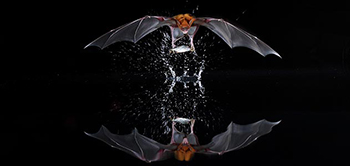Greater Bulldog Bat or Fisherman Bat
Noctilio leporinus

TAXONOMY
Kingdom Animalia
Phylum Chordata
Class Mammalia
Order Chiroptera
Family Noctilionidae
Genus Noctilio
Species N. leporinus
HABITAT
Fisherman bats inhabit much of the Neotropics, from central Mexico extending down to northern Argentina and many Caribbean islands (Gannon et al., 2005). They prefer to live near coastal areas or lowlands and much stay near a water source, lending to a somewhat patchy distribution.
FOOD
As the name implies, fisherman bats are piscivores, meaning they consume fish. Unique adaptations allow these bats to efficiently catch fish, even though they cannot see very well. Echolocation is used to detect ripples in the water made by swimming fish (Suthers, 1965). Once the bat locates a fish, it can quickly swoop down and catch the fish with its large, sharp claws. Fisherman bats also have long hind legs and large feet to aid in catching its prey (Nowak, 1999). In addition to fish, these bats will also feed on various insects, as well as shrimp and crabs (Brooke, 1994).
BEHAVIOR
Fisherman bats gather in groups and have many roosting sites including caves, hollow trees and rock fissures (Gannon et al., 2005). Some colonies have less than 100 individuals, while others have been observed to contain hundreds of individuals at one roosting site. Within roosts, there are smaller groupings containing two to nine adult females and one adult male. This resident male copulates with females in his group, while bachelor males reside with other bachelor males who are not currently involved in copulation or the rearing of young. Fisherman bats are nocturnal and spend about 2.5 hours foraging per night, and are even known to return to the same foraging site in successive years (Brooke, 1994).
Both males and females produce an oily fluid from glands underneath the wings (Brooke and Decker, 1996). These secretions have a very apparent odor, which make it easy to know if a fisherman bat is nearby. Members of the same roosting group coat one another with the odiferous secretions. Chemical composition of fluids varies between individuals and sexes and can possibly serve many purposes, such as individual identification or to communicate reproductive readiness.
REPRODUCTION
Breeding normally begins in November and December with gestation continuing into the winter months and the beginning of spring (Hood and Jones, 1984). Females give live birth to only one young per pregnancy, usually from late April to June. There is usually only one litter per year. Young do not fly until thirty-five to forty-four days of age and have a strong maternal attachment, with weaning not occurring until seventy-five to ninety-five days of age (Eisenberg et al., 2000). After weaning, young feed on masticated food from the mother’s cheek pouches. Females nurse only their own young, which they can recognize via vocal signals. Parental care of the young is normally exhibited by both the mother and the father (ADW).
RECENT RESEARCH
A recent study performed on the fisherman bat focused on determining if a correlation existed between activity and the lunar cycle. By observing bat activity over one lunar cycle, it was determined that a correlation did exist between activity and level and darkness. The bats where much less active when the moon was at its brightest state, and more active the darker the night became as the lunar cycle progressed. This pattern of behavior is termed “lunar phobia” because the bat shies away from the intense brightness of the moon. It has been hypothesized that this behavior is a predator adaptation to allow for greater odds of success that a bat will successfully catch its prey if the prey has a smaller chance of seeing it approach (Bork, 2006).
ECONOMIC/ECOLOGICAL IMPORTANCE
Fisherman bats may pose a problem for hatcheries or aquaculture projects. If the bats have access to fish, they will prey upon these fish and may significantly reduce their numbers. Therefore, it is wise for hatcheries to invent ways of preventing echolocation to minimize losses (AWD).
Although the fisherman bat is not considered to be a threatened species, there have been reports that cave disturbances have led to decreased bat numbers on the island of Curacao (AWD).
PERSONAL INTEREST
I chose the fisherman bat because I am interested in the evolutionary history of bats in general. Their adaptations for flight are truly remarkable, and the seemingly limitless number of bat species leaves much room for exploration and learning. The fisherman bat is no exception, with their amazing ability to catch fish via echolocation aided by the elegant elongation of hind limbs and claws. A flying mammal is something to get excited about!
LITERATURE CITED
Bork, K. S. (2006). Lunar phobia in the greater fishing bat Noctilio leporinus. Int. J. Trop. Biol., 54: 1117-1123.
Brooke, A. (1994). Diet of the fishing bat, Noctilio Leporinus. Journal of Mammalogy, 75: 212-219.
Brooke, A., and D. Decker. (1996). Lipid compounds in secretions of fishing bat, Noctilio leporinus. Journal of Chemical Ecology, 22: 1411-1428.
Eisenburg, J. F., and K. H. Redford. (2000). The Central Neotropics: Ecuador, Peru, Bolivia, Brazil. Chicago: University of Chicago Press.
Gannon, M. R., A. Kurta, and A. Rodriguez-Duran. (2005). Bats of Puerto Rico: An Island Focus and a Caribbean Perspective. Lubbock, TX: Texas Tech University Press.
Hood, C.S., and J. K. Jones. (1984). Noctilio leporinus. Mammalian Species, 216: 1-7.
Mulheisen, M., and K. Berry. (2000). Noctilio leporinus. Animal Diversity Web (ADW) from the University of Michigan Museum of Zoology. Retrieved May 27, 2013, from http://animaldiversity.ummz.umich.edu/accounts/Noctilio_leporinus/.
Nowak, R. M. (1999). Walker’s Mammals of the World (Volume I). 6th ed. Baltimore: Johns Hopkins University Press.
Suthers, R. A. (1965). Acoustic orientation by fish-catching bats. Journal of Exp. Zoology, 158: 319-348.
EXTERNAL LINKS
http://animaldiversity.ummz.umich.edu/accounts/Noctilio_leporinus/.